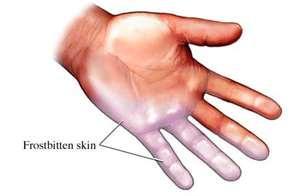Frostbite is caused by extreme cold—an hour of exposure at 20 degrees Fahrenheit is all it takes. Even colder temperatures, or exacerbating factors such as moisture or wind, will increase the likelihood of frostbite setting in.
 Common signs of frostbite include numbness, tingling and pain in the exposed areas (usually extremities, or fingers, toes and the nose), followed by painful blistering. Cell damage occurs both at the time of exposure (ice crystals form in the space outside of the cells), and after exposure, which results in damage to the blood vessels due to lack of oxygen in affected tissue.
Common signs of frostbite include numbness, tingling and pain in the exposed areas (usually extremities, or fingers, toes and the nose), followed by painful blistering. Cell damage occurs both at the time of exposure (ice crystals form in the space outside of the cells), and after exposure, which results in damage to the blood vessels due to lack of oxygen in affected tissue.
There are three degrees of frostbite, similar to a hot burn scale: first degree, signified by irritation and redness; second degree, which results in clear, painful blisters; and third degree, the most severe, in which bloody blisters eventually result in black, dead tissue.
First Aid for Frostbite
If you or someone you know believes they may have frostbite, use the following steps to reduce the damage it can cause:
- Move to a warm environment, if possible. If the victim is also experiencing hypothermia, make sure to keep their core body warm. Saving a life is more important than saving a limb.
- Remove all wet or constrictive clothing and jewelry to encourage blood flow to the affected area.
- Keep extremities elevated in order to reduce swelling.
- Rewarm the affected area with a 40-degree water bath. Do not try to rewarm the frostbitten tissue with hot water. The cells are more fragile, and the tissue is less sensitive to temperature, and this can result in severe burns.
- Do NOT re-warm the injured area if there is any chance that it will refreeze. Ice crystals formed in between cells will be larger the second time they form.
- Get to the hospital as soon as possible. The final amount of tissue damage is proportional to the time it remains frozen, not to the absolute temperature to which it was exposed.
Source: Article by David Harrington, MD, Director of the Rhode Island Burn Center

